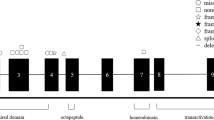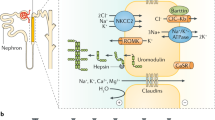Abstract
Familial juvenile nephronophthisis (NPH) is a chronic autosomal recessive kidney disease responsible for 15% of end stage renal failure in children. NPH is frequently (16% of cases) associated with Leber amaurosis (termed Senior-Løken syndrome, SLS). Linkage analyses, performed in 22 multiplex NPH families (18 without and 4 with ocular abnormalities), have localized the gene to a region between D2S48 and D2S51 on chromosome 2p. This was confirmed using adjacent microsatellite markers, one of which (AFM220ze3 at the D2S160 locus) gave a lod score of 4.78 at Θ = 0.05 in the 18 families with isolated NPH, whereas the same marker excluded linkage with SLS. These results demonstrate linkage of the purely renal form of NPH to chromosome 2p, and suggest that there may be genetic heterogeneity between NPH and SLS.
This is a preview of subscription content, access via your institution
Access options
Subscribe to this journal
Receive 12 print issues and online access
$209.00 per year
only $17.42 per issue
Buy this article
- Purchase on Springer Link
- Instant access to full article PDF
Prices may be subject to local taxes which are calculated during checkout
Similar content being viewed by others
References
Kleinknecht, C. & Habib, R. Nephronophthisis. In Textbook of Clinical Nephrotogy (eds Cameron, J.C. et al.) 2188–2197 (Oxford University Press, Oxford, 1992).
Fanconi, G. et al. Die familiäre juvenile Nephronophthise. Helv. Paediatr. Acta 6, 1–49 (1951).
Strauss, M.B. & Sommers, S.C. Medullary cystic disease and familial juvenile nephronophtisis. New Engl. J. Med. 277, 863–864 (1967).
Smith, C.H. & Graham, J.B. Congenital medullary cysts of the kidneys with severe refractory anemia. Am. J. Dis. Child. 69, 370–378 (1945).
Waldherr, R., Lennert, T., Weber, H.P., Fodish, H.J. & Schärer, K. The nephronophthisis complex. Virchows Arch. [A] 394, 235–254 (1982).
Cohen, A.H. & Hoyer, J.R. Nephronophthisis. A primary tubular basement membrane defect. Lab. Invest. 55, 564–572 (1986).
Foxman, S.G., Heckenlively, J.R., Bateman, J.B. & Wirtschafter, J.D. Classification of congenital and early onset retinitis pigmentosa. Arch. Ophtalmol. 103, 1502–1506 (1985).
Senior, B., Friedmann, A.I. & Braudo, J.L. Juvenile familial nephropathy with tapetoretinal degeneration. A new oculorenal dystrophy. Am. J. Ophtalmol. 52, 625–633 (1961).
Løken, A.C., Hanssen, O., Halvorsen, S. & Jølster, N.J. Hereditary renal dysplasia and blindness. Acta Paediatr. 50, 177–184 (1961).
Edwards, J.H. Exclusion mapping. J. med. Genet. 24, 539–543 (1987).
Weissenbach, J. et al. Second generation genetic linkage map of the human genome. Nature 359, 794–801 (1992).
Spurr, N.K. & White, R. Report of the comittee on the genetic constitution of chromosome 2, Human Gene Mapping 11 (1991). Cytogenet. Cell Genet. 58, 142–169 (1991).
O'Connell, P. et al. Twenty loci form a continuous linkage map of markers for human chromosome 2. Genomics 5, 738–745 (1989).
Ott, J. The variability of the recombination fraction. In Analysis of Human Genetic Linkage. 194–216 (The John Hopkins University Press, Baltimore, 1991).
Spurr, N.K. & Naylor, S. Report of the first international workshop on human chromosome 2 mapping. Cytogenet. Cell Genet. 60, 82–86 (1992).
Davisson, M.T., Guay-Woodford, L.M., Harris, H.W. & D'Eustachio, P. The mouse polycystic kidney disease mutation (cpk) is located on proximal chromosome 12. Genomics 9, 778–781 (1991).
Zerres, K. Genetics of cystic kidney diseases in children. Pediatr. Nephrol. 5, S23 (1991).
Bulfield, G., Siller, W.G., Wight, P.A. & Moore, K.J. X chromosome-linked muscular dystrophy (mdx) in the mouse. Proc. natn. Acad. Sci. U.S.A. 81, 1189–1192 (1984).
Norby, S. & Schwartz, M. Possible locus for polycystic kidney disease on chromosome 2. Lancet 336, 323–324 (1990).
Hazan, J., Dubay, C., Pankowiak, M.P., Becuwe, N. & Weissenbach, J. A genetic linkage map of human chromosome 20 composed entirely of microsatellite markers. Genomics 12, 183–189 (1992).
Lathrop, G.M., Lalouel, J.-M., Julier, C. & Ott, J. Strategies for multilocus linkage analysis in humans. Proc. natn. Acad. Sci. U.S.A. 81, 3443–3446 (1984).
Rizzoni, G. et al. Combined report on regular dialysis and transplantation of children in Europe, 1990. Nephrol. Dial. Transpl. 62 (suppl. 4), 31–42 (1991).
Author information
Authors and Affiliations
Rights and permissions
About this article
Cite this article
Antignac, C., Arduy, C., Beckmann, J. et al. A gene for familial juvenile nephronophthisis (recessive medullary cystic kidney disease) maps to chromosome 2p. Nat Genet 3, 342–345 (1993). https://doi.org/10.1038/ng0493-342
Received:
Accepted:
Issue Date:
DOI: https://doi.org/10.1038/ng0493-342
This article is cited by
-
From juvenile hyperuricaemia to dysfunctional uromodulin: an ongoing metamorphosis
Pediatric Nephrology (2016)
-
Nephronophthisis
European Journal of Human Genetics (2009)



